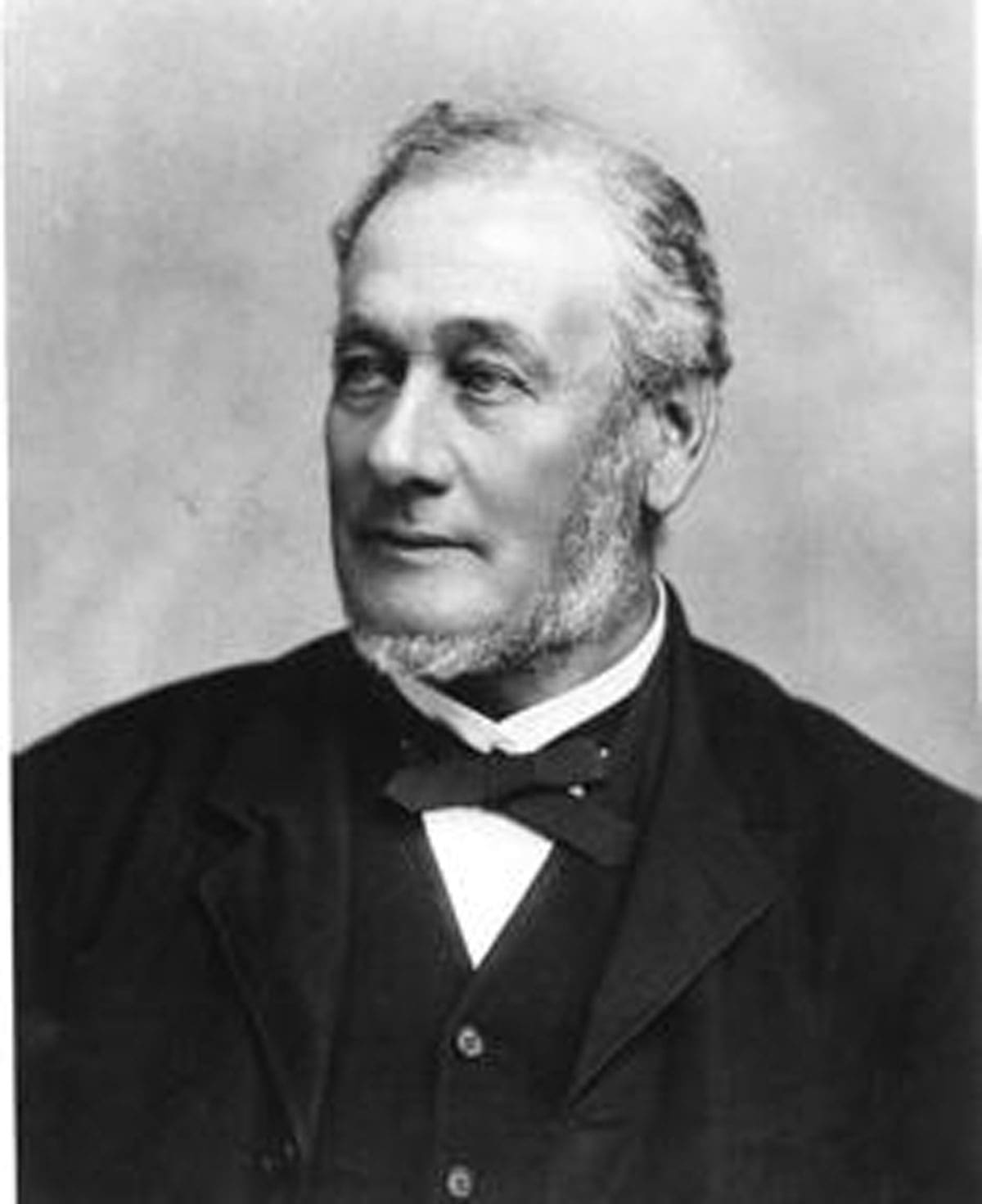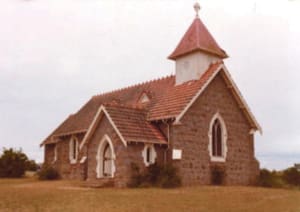Barry Thorsby, gave a presentation to the Harden-Murrumburrah Historical Society in November 2002. The following is an insight into the Currawong property, homestead and church. That small area has played a significant part in not just the history of our region, but also in the history of this country. The founder of Currawong, James Roberts, was born in Sydney in 1812 and died in 1876 at the aged of 64. Roberts arrived in the area in 1828 at the age of 16, and was among the first settlers in the area. His property, Currawong, has the unique distinction of being the only one in the district continuously occupied by the descendants of the man who first squatted on it. The original buildings at Currawong consisted of a series of slab huts built along the creek. In the late 1830s, a homestead was built of brick consisting of five rooms, with a kitchen detached from the main building as was the custom with early homestead buildings. The current sitting room at the homestead was once used as the Harden Post Office (see below).
James Roberts was slow to build the grand homestead befitting an established squatter. However, in the 1870s, Currawong Homestead was built in all of its glory. It is connected to the original building by a breezeway, and built with a wood shingle roof and plaster ceilings. James Roberts’ nephew, Richard Hutchinson (R.H.) Roberts, had the shingles covered with corrugated iron and the ceilings covered with Wunderlich pressed steel. As Barry stated, “the Currawong roof and ceilings are now four layers thick.”
The area known as the ‘Wing’ was originally constructed of wood, but was burnt down. It was then rebuilt of granite at the same time that the stables, coach house and Currawong Church were built (between 1916 & 1919). “The imposing coach house has a high pitched loft along its top, and we are told that police and bushrangers slept there on occasions (obviously not at the same time),” said Barry. The stables consist of eight separate horse bays plus a harness and feed room. These were built in conjunction with Roberts’ well-known reputation for breeding thoroughbred horses and Clydesdales. Currawong held many woolshed and grainshed dances, and also boasted a tennis court and a cricket pitch. The property eventually held by James Roberts comprised Currawong – 35,480 acres and Milong – 9,600 acres for a total of 45,000 acres. In 1840, he employed four men, but by 1848 he had a staff of 16 and was growing 18 acres of wheat and 30 acres of hay.
In addition to his agricultural pursuits, Roberts also established a passenger coach service from Young via Murringo and Boorowa and on to Yass, with a departure time from Young of 7:00am and a fare of £2. He increased his interests in this industry by taking over the mail run from Young to Yass via Wombat, Redbridge and Murrumburrah, which ran four times per week. In 1870, Roberts opened a Post Office at Currawong, trading under the name Harden Post Office and earned £12 per year as Post Master. The office was subsequently transferred to Harden.
The most significant event in the history of Currawong was the Lambing Flat Riots. On the 30th of June 1861, a mob of between 1,500 and 2,000 drove off Chinese miners working at Lambing Flat, before moving on to destroy and loot an encampment of between 150 and 200 Chinese miners at the Back Creek diggings. The violence was allegedly triggered by the rumour that 1,500 Chinese were on their way to Lambing Flat, as well as the failure of the Anti-Chinese Immigration Bill in the New South Wales Legislative Assembly. There is, however, far more to the incident and its causes than can be conveyed in a mere paragraph. But the effect of the event, and others similar on other gold fields, arguably provided the catalyst for the institution of the White Australia Policy upon Federation in 1901. It was not until 1973 that the policy was fully disman tled under the Whitlam Government. As a result of the violence, over 1,000 Chinese miners retreated to Currawong, where, at some risk, James Roberts allowed them to camp. The Chinese remained on Currawong from the 30th of June until the 15th of July. Roberts obtained permission to “supply the destitute Chinese with the necessities of life.” The rations comprised flour, beef, tea & sugar. Roberts, however, subsequently claimed compensation for the rations supplied, but as the number of Chinese varied according to the official report and Roberts’ report, he was paid a reduced amount some eight months later. The fun didn’t stop there for Roberts. Two years later on the 16th of June, 1863, Ben Hall’s gang of bushrangers stole two racehorses from the Currawong property. It was certainly an eventful couple of years for them. James Roberts died without issue, and left Currawong to his nephew Richard Hutchinson (R.H.) Roberts. In his Will, he left money to the Anglican and Presbyterian Churches in Young, as well as leaving land, money or stock to his employees.
R.H. Roberts arrived at Currawong in 1876, and was a Member of the Legislative Council from 1864 to 1869. After he died in 1903, he left the property to his two sons William Camden Hutchinson (W.C.H.) Roberts and Sydney Everett Roberts. W.C.H. Roberts received Currawong, and Sydney received Tiverton. W.C.H. Roberts had three sons, Richard (the grandfather of the current occupant of Currawong, Brad Thorsby), Rupert, and Harold, as well as two daughters, Rosina (who married Walter Kendall) and Ella (who married Arthur Davison). Upon his death, W.C.H. Roberts left his property to his five children, to be divided equally amongst each of them (approximately 1600 – 1700 acres each). Richard, who had been managing the property, was to have the section including the Currawong Homestead. Richard Hutchinson Roberts had one son and one daughter. His son David predeceased him, dying of polio at the age of 25. On his death in 1969, he left the Currawong property and homestead to his daughter Jill, the wife of Barry Throsby and the mother of Brad, who currently runs the property.
One of the most iconic landmarks at Currawong is St Mark’s Anglican Church. For a Hennessy Catholic College student from Harden, the school bus would pass the church twice a day, allowing a few seconds each time to study the church and its grounds in any detail. It was certainly the highlight of an otherwise unstimulating hour each, unless blackjack was being played on the bus, which it often did.
For 33 years until 1919, services were held in an un-consecrated galvanised iron church. St Mark’s was built on five acres of land donated by W.C.H. Roberts and his wife Victoria for a church and graveyard. W.C.H Roberts and his brother Sydney of Tiverton financed the building of the church.
The inlaid marble panel foundation was laid on the 12th of March, 1918, by Victoria Roberts – “In loving memory of R.H. Roberts M.L.C & his wife Susan.” The Rector, the Reverend Henry Hamiltonn Crigan designed the church and supervised its erection by Millard & Sons of Young. The church is an excellent example of Norman style architecture. It is built of blue polished granite from the Currawong property. The roof and belfry of the church are covered in red terracotta tiles and the pointing around the windows, doors and at the top of the buttresses are of red brick. The sanctuary is laid with red and black tiles, and the altar steps are of white marble. The furniture, of selected oak, was presented by different families of the congregation. The church bell came from Belgium.
The church and graveyard were consecrated by the Bishop of Goulburn, the Right Reverend Dr Lewis Radford (after whom Radford College in Canberra is named), on the 11th of May, 1919. 600 people of all denominations attended. During the consecration, two infant grandsons of W.C.H. & Sydney Roberts were baptised. Some water from the Jordan River was added to the baptismal water by William Kendall upon his return from serving in the Great War. For 44 years, water from this bottle was used in this fashion until the last of it was used in the baptism of Brad Thorsby in 1963.
The first marriage was celebrated on the 16th of July, 1919, in St Mark’s. The parties being John J. Walker & Vera King. There were regular services of Holy Communion, as well as baptisms and funerals, until dwindling congregations forced the closure of the church in 1977. It was re-opened in 1981 and services were held on the 5th Sunday of the month, but it was again closed in 1985. The church became neglected and was subjected to many acts of vandalism. The prospect of selling the church was even considered by the Parish Council. However, on September 3rd, 1989, following a service of Morning Prayer conducted by residents of the Currawong community, the decision was made to raise money to restore the church. The work of restoration began immediately, and Rector Christopher Elliott commenced monthly services of Holy Communion. These services helped to cement a rapidly growing bond between the Currawong families.
On the 4th of November 1990, a celebration service was conducted by Bishop Ian George to mark the re-dedication of the fully restored church of St Mark’s. Thankfully, services are still conducted regularly to this day at the church. Currawong has been a place of significance for many over the nearly two centuries it has been in existence. It provided a refuge for those in need, and still provides a living as well as a place of sanctuary for landowners and parishioners alike. It may be small, but it has played a pivotal role in the history of our region. Thank you to the Harden-Murrumburrah Historical Society for their valuable assistance.


